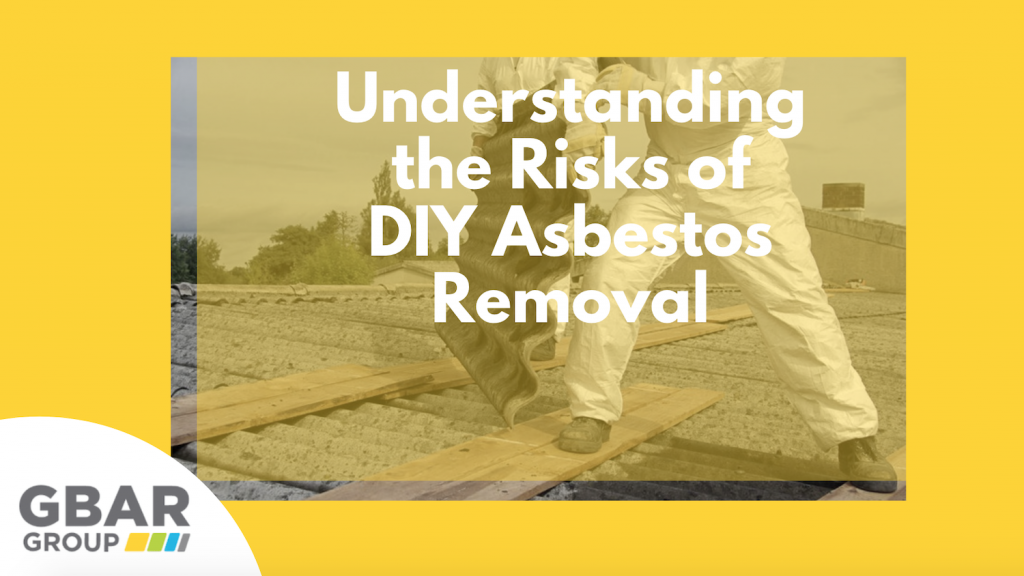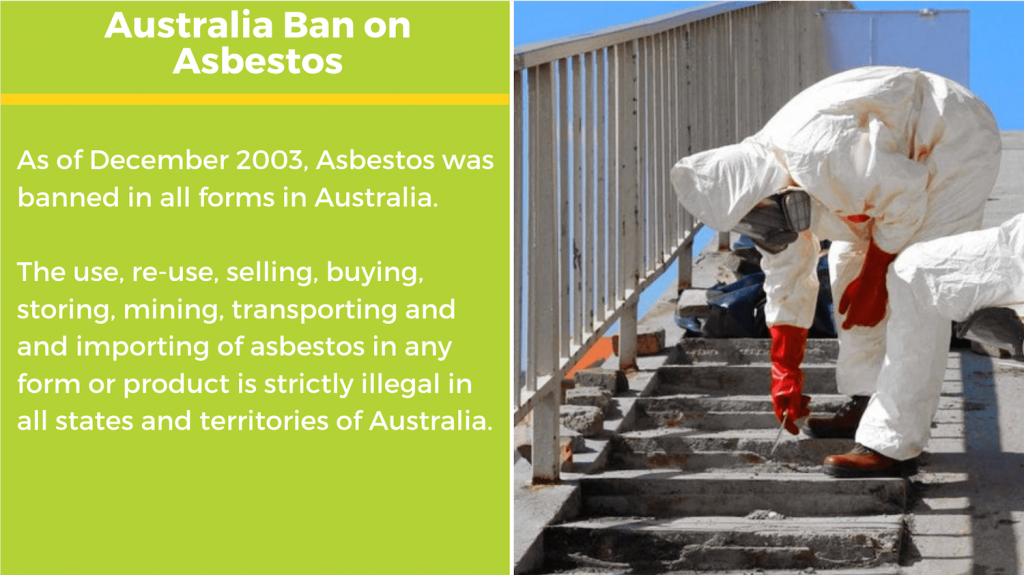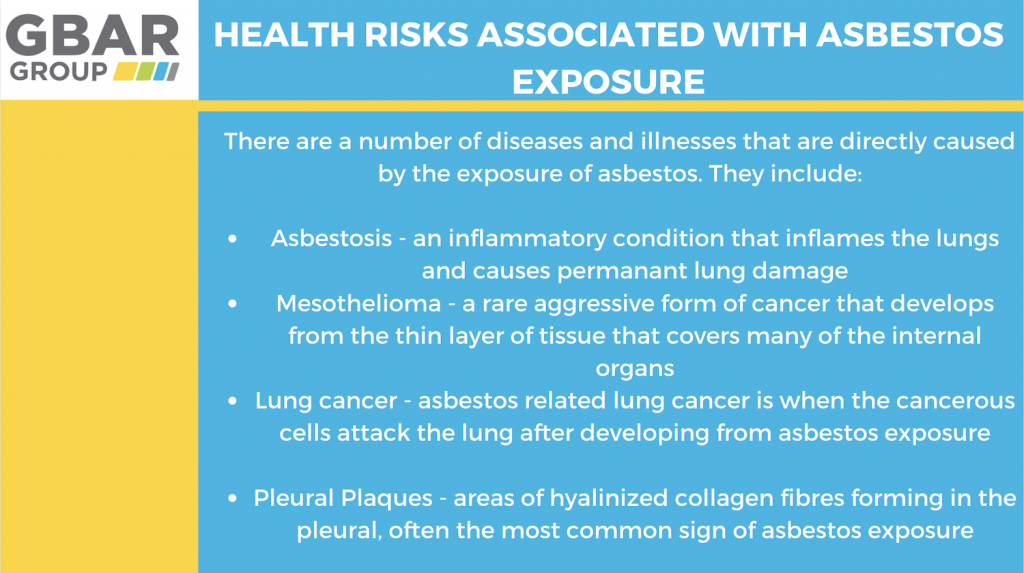
Asbestos removal can be extremely dangerous, especially in cases where asbestos materials are damaged or disturbed. Irrespective of the volume or regularity of exposure, removing or handling asbestos without the proper training and certification is fraught with risk. Research from the Australian Environmental Protection Authority has revealed that there is no ‘safe level’ of asbestos exposure.
It’s easy to understand why some homeowners are attracted to the idea of undertaking a house project by themselves – it can be cheaper and DIY work comes with a sense of pride in finishing something with your own hands. However, some projects are simply too complicated, dangerous, and are associated with too many risks that realistically, outweigh the benefits of completing the work yourself. DIY asbestos removal falls firmly into the latter category.
It’s estimated that more than a million Australian homes were built from asbestos sheeting and even more contain asbestos-related materials. If your house was built prior to 1990, odds are, it contains asbestos somewhere. Before jumping into any do-it-yourself weekend renovation work around the home, it’s important to understand the prevalence and risks of asbestos exposure in a residential capacity.
The Use of Asbestos in Australia
During the peak period of asbestos consumption, Australia was one of the highest users of asbestos per capita. Prior to the increased awareness of the dangers of asbestos, it was heavily used on residential, commercial, and industrial sites. The properties of asbestos fibres meant that asbestos provided great strength, durability, heat resistance, chemical resistant and did not conduct electricity. It was considered an excellent building and manufacturing material that was versatile, affordable and increasingly accessible.

Asbestos was marketed during the 1930s as fireproof, durable, easily transported and perfect for all Australian climates because of its thermal qualities. The nature of asbestos fibres makes it a perfect candidate to be woven and mixed with other materials for stronger products. With usage peaking around 1945 and 1960, the use of asbestos products only continued to grow until the late 1980s.
Friable asbestos products were commonly used in both commercial and industrial settings as early as the late 1800s for fireproofing, soundproofing and insulation. Some friable products were also used in houses in products like insulation and may still be found in houses built before 1990.
Non-friable asbestos was a common addition to other building properties to offer beneficial properties to the materials. Asbestos was often mixed in with cement and used for asbestos cement sheeting in residential construction. Although this form of asbestos does not pose a threat if the materials are undisturbed and stay tightly bonded, once the cement or material wears, becomes damaged, or is broken, the asbestos becomes friable and the harmful fibres are released.
Mining of asbestos in Australia began in the 1930s when the discovery of crocidolite (blue asbestos) was made in Western Australia. By the 1940s, several mines were in operation, with Wittenoom in Perth, Western Australia, being declared as one of the most dangerous and contaminated sites. Australian mines were closed down from the 1980s due to the direct associated of illnesses being suffered by asbestos workers from the harmful working conditions.
DIY Asbestos Removal Regulations in Australia
Asbestos exposure is incredibly harmful and is directly linked to the development of chronic illness. In the year 2003, Australia finally put legislation in place to protect Australians from future harm of asbestos.
Once used in a wide range of building materials, consumer goods and other commercial products due to its low price, durability and fire-resistant properties, asbestos is now one of the most heavily regulated materials in Australia.
Regulations were put into place from the 1980s as the awareness of asbestos dangers increased. During the 1980s, asbestos cement materials were phased out in favour of asbestos-free products. Since December 31st, 2003, asbestos in all forms, products, and materials has been banned nation-wide. The use, re-use, selling, buying, storing, mining, transportation and importing of asbestos fibres is strictly illegal in all states and territories of Australia. This ban in 2003 was accompanied by a thorough nationwide campaign warning of the dangers of asbestos exposure.

Today, the use of asbestos is heavily regulated in Australia. As are the legislations around the testing, handling, removal, and disposal of asbestos products. The issue we now face in Australia is the high demand for asbestos removal as our buildings began to age and wear, exposing the harmful fibres that were once used to construct them.
DIY or ‘Do It Yourself’ asbestos removal is not recommended and in some states of Australia, is illegal. In the ACT, all asbestos removal work must be carried out by a licensed asbestos removalist. In all other states and territories, a non-licensed person is legally allowed to remove non-friable asbestos, provided the area is no larger than 10m2.
Who Is at Risk of Asbestos Exposure?
Asbestos exposure occurs when the tiny fibres are inhaled and become lodged in the lungs of a human. History saw those that were working in the mining, construction, and manufacturing industries bear the brunt of asbestos exposure. For a long time, thousands of workers were unknowingly being exposed to asbestos fibres in which would later cause fatal health concerns. It wasn’t until the development of asbestosis cases and increased awareness of asbestos health effects that occupational asbestos exposure was taken seriously.
Up until the nation-wide ban of asbestos, it was those who worked with asbestos or around asbestos fibres that were most at risk of asbestos exposure. However, these days, asbestos exposure can happen to anyone, in any environment that has been affected by asbestos.
In most cases, the individual exposed to asbestos will go years without realising that they have been adversely affected as symptoms can take decades to be detected. Although asbestos exposure is most common to those working in the construction industry, individuals may also be exposed to asbestos in their home, workspace, and other community spaces.
Those who undertake DIY asbestos removal or even DIY home renovations on older houses without asbestos testing are now at the highest risk of being exposed to asbestos in Australia. DIY asbestos removal is strongly advised against in Australia, by the EPA, WorkSafe Australia and the Asbestos Safety and Eradication Agency.
What are the Health Hazards of Asbestos Exposure?
Asbestos exposure may occur in the home, workplace, or in the general community. When asbestos-containing products are disturbed, tiny asbestos fibres are released into the air which can cause serious health and respiratory problems for those who come into contact with the material. When asbestos fibres are inhaled, they become trapped in the lungs and remain there indefinitely which can cause inflammation, scarring, and irreversible respiratory problems.
The most common side effects of asbestos exposure include asbestosis (an inflammatory condition that inflames the lungs and causes permanent lung damage) and other non-malignant lung diseases and pleural disorders including pleural thickening, benign pleural effusions, and pleural plaques. According to data from the International Agency for Research on Cancer, there is sufficient evidence to suggest that asbestos causes mesothelioma and cancers of the larynx, lungs, and ovaries. Despite being statistically rare, mesothelioma is the most common form of cancer directly linked with asbestos exposure.

Asbestos-Related Illnesses include:
Malignant Asbestos-Related Disease
- Mesothelioma, pleural and peritoneal
- Lung Cancer
- Ovarian Cancer
- Laryngeal Cancer
Malignant disease Possibly Linked to Asbestos Exposure
- Pharyngeal Cancer
- Stomach Cancer
- Colon Cancer
Non-malignant Asbestos-Related Diseases
- Asbestosis
- Pleural thickening
- Pleural thickening
- Atelectasis
- Peritoneal effusion
- Pericardial effusion
- Hyaline pleural plaques
Do-it-yourself work provides the perfect opportunity for asbestos exposure to occur unknowingly, as asbestos fibres are difficult to identify and to the naked eye, look like tiny dust particles. Asbestos-related illnesses can take decades to develop and symptoms will only arise after a few years, if ever. The most consequential risk of DIY Asbestos removal is the risk it poses to one’s health.
Does My Property Contain Asbestos?
Most homes built in Australia post the mid-1990s will not contain asbestos materials in any capacity. However, the same cannot be said for homes constructed between the end of World War 2 and the mid-1970s when asbestos use was prevalent in a wide range of commercial and residential construction materials. Even if your house was built after the 1990s, there’s a chance it might contain products that were manufactured with asbestos fibres. Some of the most common residential applications of asbestos materials include:
- Floor Tiles
- Carpet Underlay
- Cement Sheet
- Cement Roofing
- Roof Shingles
- Fences
- Ceiling Panels
- Fireproofing Materials
- Paint
- Internal Walls
- Sheds
- Insulation Materials
- Steam Pipes
- Patching & Joint Compounds
- Door Gaskets
- Decorative Materials
- Soundproofing Materials
Any exposure to the elements and weathering can make asbestos materials fragile and dangerous to handle. Disturbing bonded asbestos materials by cutting, sawing, smashing, moving and sanding, will allow the material to become airborne. A DIYer may not be aware of the running risk of breaking asbestos materials and releasing hazardous fibres into the air.
Prior to undertaking any home renovations, older homes should be tested for asbestos materials. Appropriate asbestos removal cannot be 100% certain without the lab accredited testing of the fibres. The only way to properly and safely identify asbestos in the home is to have samples taken and tested by an asbestos specialist.
The Dangers of DIY Asbestos Removal
Apart from the obvious health concerns associated with DIY asbestos removal, there are a few other factors to consider when taking the risk.
For one, any regular handyman power tools cannot be used for the removal or handling of asbestos materials. Power tools, cutting or sanding discs, compressed air and high-pressured hoses will disturb the material and allow the release of the fibres into the air. This is why the reliance on asbestos professionals is advised – they know what they are doing. Licensed asbestos removalists have been thoroughly trained and educated on the proper handling of asbestos materials to avoid contaminating further areas.

Secondly, if you are planning to remove asbestos materials from your home, Australian law requires you to take your local council into consideration. The local council needs to be notified and will give sufficient information on the appropriate disposal of asbestos materials – asbestos cannot be thrown into the regular waste and needs to be properly packaged and disposed of at an approved facility.
Thirdly, your neighbours will need to be consulted prior to the DIY asbestos removal. Through the Health Act 1858, Australian residents can call upon the environmental health officer of a local council when they become aware of nuisances that are deemed dangerous to public health. Should you fail to undertake the appropriate safety measures and precautions, you may be subjected to an investigation.
The health risks alone should be enough to deter anyone from DIY asbestos removal in Australia. Apart from these dangers, DIY asbestos removal can be downright inconvenient due to the sheer number of safety precautions that need to be taken in order to limit these risks.
Be Safe, Get an Inspection
Before commencing any serious construction work around the house, it’s a good idea to have your property inspected by a licenced asbestos removal professional. Removing asbestos is a complicated and risky business, GBAR Group’s asbestos professionals are trained, licenced and equipped to handle and dispose of hazardous materials.
Taking the DIY asbestos removal route is fraught with risk, it’s best to consult a professional who can help you to identify and dispose of hazardous materials before you begin construction. GBAR Group is committed to removing the risk of asbestos and providing clean, safe, and healthy environments for others.





